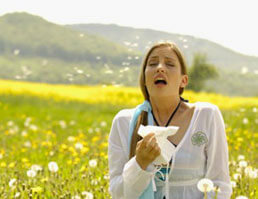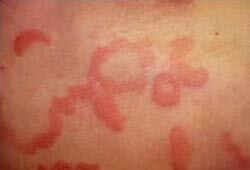Medicinal allergy
 Drug allergy - caused by various components of medications allergic reaction of the body. Nowadays, allergy to medicines is an urgent problem not only of allergic people, but also of the doctors treating them. It is they who are directly responsible for the appointment of each medication. More often than not, people take medicines themselves, relying on advice received from television advertising on the treatment of a particular disease. The greatest danger and represent exactly these drugs, and they are released in pharmacies without the prescription of a doctor. In almost 90% of people susceptible to this allergic manifestation, medicinal allergy is caused by over-the-counter antibiotics( cefuroxime, penicillin), sulfanilamide preparations( biseptol, septrin, trimethoprim) or regular aspirin.
Drug allergy - caused by various components of medications allergic reaction of the body. Nowadays, allergy to medicines is an urgent problem not only of allergic people, but also of the doctors treating them. It is they who are directly responsible for the appointment of each medication. More often than not, people take medicines themselves, relying on advice received from television advertising on the treatment of a particular disease. The greatest danger and represent exactly these drugs, and they are released in pharmacies without the prescription of a doctor. In almost 90% of people susceptible to this allergic manifestation, medicinal allergy is caused by over-the-counter antibiotics( cefuroxime, penicillin), sulfanilamide preparations( biseptol, septrin, trimethoprim) or regular aspirin.
Drug allergy in children is not a side effect of a particular drug. In fact, this is a reaction that is caused by the individual intolerance of a particular drug substance. The development of an allergic reaction is absolutely independent of the amount of medication that has entered the body, For the development of an allergic reaction, a truly microscopic amount of an allergen-induced drug substance, which is sometimes tens of times less than the generally prescribed therapeutic dose, is sufficient. In some cases, it is enough to inhale a couple of drugs for the development of an allergy.
Drug allergies in the vast majority of cases develop only after repeated contact with the drug component provoking its development, whereas during the first contact of the immunity with the drug, the period of sensitization passes
Causes of drug allergy
In different people, the drug allergy has its own characteristics. In one case, it is a purely occupational disease that develops in completely healthy people due to prolonged contact with drugs and is often the cause of partial or complete disability. The most common occupational drug allergy is observed in people engaged in the production of medical drugs and medical workers. In another case, LA is a complication of therapeutic treatment of a certain disease( often of an allergic nature), and it significantly aggravates its course and can cause both disability of the patient and lead to death.
According to the statistical data of the center for studying the development of side effects after taking medications, it was found that in more than 70% of registered cases, the side effect on medications is allergy. According to the data of the majority of participating countries, drug allergy occurs in more than 10% of patients, and these indicators only increase annually.
The most common LA is observed in women, in relation to men 2: 1.Residents of rural areas are allergic to medicines suffer much less. Most often, LA is observed in people who have overcome a thirty-year age limit. The most common allergic response occurs after taking non-steroidal anti-inflammatory drugs, sulfonamides, antibiotics, and after tetanus vaccinations. In addition, I want to note that for the same drug LA can develop repeatedly even many years after the first case.
The longest-taking medications for patients and workers in the pharmaceutical industry are at the greatest risk of drug allergy development. Often, LA is observed in genetically predisposed people, as well as in patients with allergic and fungal diseases.
Immunoglobulins, vaccines and serum preparations are of a proteinic nature, thus being allergens due to the fact that they are capable of inducing the production of antibodies independently, after which they can react with them. The vast majority of existing medical drugs are so-called haptens, i.e. Substances that acquire their antigenic properties only after binding to serum proteins or tissues. As a result of this reaction, antibodies form which, upon repeated entry into the body of the antigen, form an antibody-antigen complex, which triggers an allergic reaction. Pharmaceutical allergy, in principle, can cause any medications, and unfortunately even those that have to fight it!
Drug pseudoallergia
In some cases, after taking a certain medication, a false allergic reaction may develop, which in its symptoms is very similar to the symptoms of anaphylactic shock. Despite the similarity of symptoms with drug allergy, with a false allergic sensitization reaction to a medical product does not occur, and as a result, the antibody-antigen reaction does not develop. In this case, a nonspecific release of mediators like histamine and histamine-like substances is observed.
Drug pseudo allergies, unlike true LA, can develop after the first administration of the drug, and with a rather slow introduction of the drug, it occurs extremely rarely, becauseThe concentration in the blood of the administered substance remains below the critical threshold, and the rate of histamine release is not increased. With drug pseudoallergies, pre-allergotests for the future administration of the drug give a negative result.
Providers of histamine release may be blood substitutes( dextran), alkaloid preparations( papaverine), opiates, desferal, polymyxin B, no-sppa, etc. An indirect sign of a pseudoallergic reaction is the absence of a weighed allergic anamnesis. A favorable background for the development of drug pseudoallergies are chronic infections, gastrointestinal tract diseases, vegetovascular dystonia, liver diseases, diabetes mellitus. Also, the development of pseudoallergia can trigger uncontrolled overuse of medications
Drug allergy - symptoms
When treating with drugs, the following complications and body reactions may develop:
• Side effects( abdominal pain, headache, etc.).A list of all possible side effects is indicated in the instructions of each medication. For example - after taking antihistamines, you may experience dizziness and drowsiness
• Toxic reactions. These manifestations occur if the permissible dosage of the drug is exceeded. Most often, toxic reactions develop in patients with kidney and liver diseases, as in these cases, the excess dose of the drug occurs in the affected kidneys and liver due to deterioration of excretion of
medications. • Allergic reactions
• Cancellation reaction. This reaction occurs if discontinuation of previous long-term treatment with certain
medications occurs. • Secondary effects. These include fungal lesions of the mucous membranes, disruption of the normal intestinal microflora and pr
As it occurs, the drug allergy is divided into two types:
• Immediate. Occurs almost immediately after the administration or administration of a provoking substance. Immediate reactions include allergic edema, hives and anaphylactic shock. In most cases, such reactions develop after the introduction of penicillin, as well as its analogues. Due to the fact that antibiotics of the penicillin series have a similar chemical structure, when a drug allergy develops on one of them, a reaction to other drugs of this group is also possible. Immediately after the administration of penicillin, a rash may appear, which is manifested by red spots rising above the surface of the skin. Unfortunately, the allergic response of the immune system to the rash may not be limited, and after a while a much more serious reaction may develop such as anaphylactic shock
• Slowed down. Occurs after a few days and as a result, it is often impossible to establish the exact cause of the allergic reaction. There is a delayed drug allergy changes in blood composition, joint pain, hives, fever. In addition, a few days after taking the drug, reactions such as: purpura, allergic vasculitis, allergic hepatitis, allergic nephritis, lymphadenopathy, astralgia, polyarthritis and serum sickness
may occur. Drug allergy-treatment
Treatment of drug allergy should first start with a complete cessationWhich caused an allergy to the medication. In the event that at the moment the patient is taking a number of drugs, all should be canceled, until the immediate "culprit" of the allergy is identified.
Often, in patients with drug allergy, there are manifestations of food allergy, as a result of which a hypoallergenic diet with restriction of spices, smoked products, acidic, sweet and salty foods, as well as carbohydrates is shown. In some cases, food allergy implies the appointment of an elimination diet, which involves the use of large quantities of tea and water.
If the patient has a mild degree of allergy, it is already much better that he begins to feel after the withdrawal of the provoking drug. In the event that allergies are accompanied by urticaria and angioedema, treatment with antihistamine drugs( diphenhydramine, suprastin, tavegil) is indicated, although it is necessary to take into account their tolerability in the past. If, after treatment with antihistamines, the symptoms of drug allergy do not subside, the use of parenteral injections of glucocorticosteroids is indicated.
When selecting an antihistamine drug should take into account the properties of all drugs in this group. An ideally selected drug against allergy besides high antiallergic activity should have a minimum of side effects when taken. These requirements are best suited to antihistamines such as Eryus, Telfast and Cetirizine.
For toxic-allergic reactions, the drug of choice are such newest antihistamines as Fexofenadine and Desloratadine. If the severe course of the drug allergy is accompanied by the development of lesions of internal organs, dermatitis and vasculitis, a good effect is achieved by taking oral glucocorticosteroids. In the case of lesions of internal organs, taking into account the likelihood of adverse reactions and allergic anamnesis, syndrome therapy is used.
In case of severe allergic reactions( Lyell's syndrome), the treatment consists of applying large doses of glucocorticosteroids, when the drug is injected every 5 hours. In such cases, treatment is mandatory in a specialized intensive care unit, as severe lesions of the skin and internal organs are observed in such patients. In addition, the therapy of such conditions implies the carrying out of activities that are aimed at restoring the acid-base and electrolyte balance, hemodynamics and general detoxification of the body.
Often at the same time as toxic skin damage, the development of the infectious process is observed, therefore, the appointment of antibiotics is additionally indicated, and the choice of the optimal antibiotic is very difficult, since it is possible to develop cross-allergic reactions.
For the purpose of detoxification and in the case of a large loss of fluid, the introduction of plasma-substitution solutions is indicated. However, it should be taken into account that these solutions can also develop an allergic or pseudoallergic reaction.
In case of extensive skin lesions, patients are treated in absolutely sterile conditions as burn patients. The affected skin is treated with sea buckthorn oil or rose hips, antiseptics, r-rum greens or blue eyes. In case of damage to mucous membranes, the lesions are treated with an anti-burn emulsion, carotolin, hydrogen peroxide. With stomatitis apply water infusions of aniline dyes, chamomile infusions, etc.



